High-end residential woodshop Alexis Cabinet Works increases volume and shop-floor efficiency with Cabinet Vision’s job-management tools
Woodworking began as just another summer job for Vance Sadler, whose first stint in a woodshop turned quickly into a passion and ultimately a career path. Today, Vance is owner of Alexis Cabinet Works, a custom high-end residential shop based in Iron Station, North Carolina, that prides itself on delivering top-notch quality and customer service.
“We’re building the kind of quality products that you can’t get without going completely custom,” says Vance, who attracts new clients primarily by word-of-mouth. “In giving our customers what they want, a high level of service is very important to us.”

To take his business to the next level in overall efficiency and production capacity, Vance needed software that could generate realistic shop drawings, as well as material and cut lists. After investigating his options, he purchased the Cabinet Vision design-to-manufacturing solution in the summer of 2017.
“I was going through and hand figuring all of my boxes and all of my cut lists,” he says. “Every single drawing was done by hand. I started looking at what my hourly rate was versus using software, and the difference was very significant. Just in labour, I’ve paid for the software twice — and I’ve had it for less than six months.”

Since implementing Cabinet Vision, Vance has hired a new full-time employee, which brings his crew up to three, including his wife, Sheila, who works in the shop part time. Though small, his team is able to take on more work while maintaining high product quality, making fewer errors, and dealing with shorter lead times.
A former employee of Vance’s returned to the job after the implementation of Cabinet Vision and was almost instantly farther along in his ability to understand the flow and logistics of production than he was when he’d left.
“I hand him drawings and everything he needs is on the cut list and the assembly sheet, so having the software has really helped him to understand how things work,” Vance says. “I can just hand the drawings and the sheets to my employees and they’re able to go from there, without more help from me. I’m extremely pleased with the software; I have no regrets or buyer’s remorse. It’s helping my business go to the next level.”
Jobs at Alexis begin when Vance visits the homes of customers to look at the spaces in which his projects will be built. He also encourages customers to submit images of finished spaces that they find aesthetically pleasing, which gives him an idea of their style preferences.

“With Cabinet Vision, I can put a design in front on my customer and they can see any changes that they want to make, and see the full layout of the project,” Vance says. “I’m very heavily involved with the customers, and even the contractors I work with turn customers over to me. One of my favorite things is sitting down with them, seeing what they really want and showing them how everything will look when it’s done.”
In addition to ironing out project details for customers, Cabinet Vision is helpful in delivering a “wow factor” for customers who may not be able to accurately visualise the end result. It’s also a handy tool for helping customers to spot project details that don’t fulfill their vision.
“I can take Cabinet Vision and make them see that when something is a terrible idea without having to say it. I think sometimes how people envision things to be built versus how they are actually built doesn’t match up,” he says. “I’ve actually sold jobs by using Cabinet Vision to help customers see what they are asking for and what really works best.”
He also uses the software to take customers on virtual tours of finished projects.
“I can open doors, open drawers, have people tell me that they have one pot or plant that they want sitting here or there. It lets the customer be very detailed with what they want to see,” he says. “I do sit down with my customers with Cabinet Vision open and go through a virtual walkthrough of the project before we ever start construction, and with a lot of customers there is pleasant shock and awe.”

While Vance has yet to implement CNC machinery, he utilises all of the job-planning tools within Cabinet Vision to streamline workflow, increase efficiency and reduce error. He and his team use the system’s ability to generate material lists, door lists, face-frame lists, cut lists, and assembly sheets on a daily basis. Though he still invests a significant amount of time in layout and design, Vance is eliminating shop-floor errors and the team is able to handle an increasing volume of work.
“Even with a learning curve from running the software, the mistakes I made were easy to correct,” he says. “I would not have been able to add a second employee as quickly as I had if I wasn’t able to hand them jobs with very minimal instructions.”
Vance also appreciates the help he gets from the Cabinet Vision team, which provided support throughout the implementation process, and is “always willing to answer my questions.”
“As we grow, I will grow with Cabinet Vision, and that is one thing I can guarantee,” Vance says. “As we grow as a shop and continue to implement more machinery, I’ll keep learning and growing with the software as it continues to evolve.”









